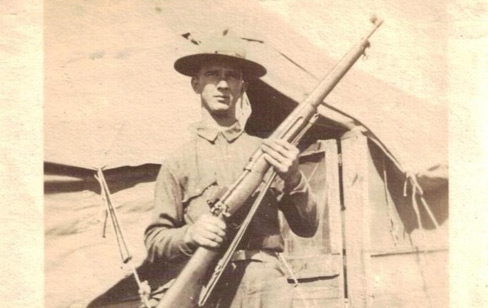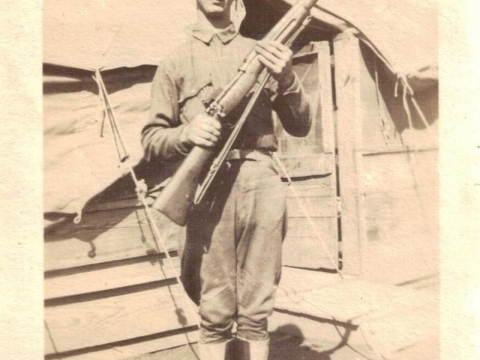Post Post 90 Columbia, Mississippi
- Home
- Post Post 90 Columbia, Mississippi
Post Post 90
Columbia, Mississippi
About This Post
Post Namesake
August 2, 2018
A Story of Our Name Sake Killed in Action during the Great War
Perm Charter Date: 10/29/1920 Last Update Date: 05/26/2016
Horatio W. Rankin – Name Sake of American Legion Post 0090, Columbia, MS 39429
Born to Thomas J. Rankin and Hettie C. Lewis on 6 May 1892 in Columbia, Marion County, Mississippi.
Raised in the Hub Community in Marion County likely attending Hub High School. Being the oldest of four children born to the Rankins he grew up like all children of that day and time with the same hopes and dreams as all children have.
The 1910 census shows him living at Beat 5, Marion County, MS age 17, being a salesman in a hardware store. Research reflects the store to be the Rankin Company Family store located near the Marion County Courthouse. One hundred twenty five years later, the buildings still stand. As a teen, he travelled the streets of Columbia like any teenager would have.
He may have met that special girl, but never had the opportunity to marry or have a family as he was drafted at 25 years old and sent to Camp Shelby, Hattiesburg, MS to be trained for maybe two weeks or less as we have been told in researching about the WWI Mississippi solders of that time.
Being drafted, he would have been with a group of other young men of the Marion County area his age, and all sent by bus to Camp Shelby. They would have gathered at the old bus station near the Columbia Courthouse for the trip to Hattiesburg. Camp Shelby exists today as one of the largest military training facilities south of Hattiesburg, MS. See below
After is abbreviated training due to demands for troops in the war effort, he traveled to New York where he boarded a British ship bound for France
He enlisted April 1, 1917 and died October 11, 1918 or 1 year 5 months and 11 days killed in action
Horatio W. Rankin 1-594-715-W
Training at Camp Shelby MS
A picture of Horatio with the 38th Infantry, 3rd Division in the streets of Meuse, Argonne France. Forty-seven days after landing in France, Horatio W. Rankin was killed in action along with 14,096 other soldiers. He never got a chance to speak with his family after training. His remains are buried in the Meuse-Argonne American Cemetery with his brothers-in-arms
Horatio W. Rankin standing in the 2nd row on streets of
Meuse, France 3 days before his death.
Death Certificate signed by General John J. (Black Jack) Pershing
Horatio W. Rankin, Private U.S. Army, 38th Infantry Regiment, 3rd Division
October 11, 1918, Commemorated In Perpetuity at Meuse-Argonne American
Cemetery, Romagne, France Plot C Row 26 Grave 23
“Time will not dim the glory of their deeds”
Horatio W. Rankin leaves for military service enlisting 1 April, 1917. He was sent to Camp Shelby MS by bus leaving from the bus station near the Columbia Courthouse and being there no more than 30 days in training. From there, he was shipped to South Carolina undergoing further training for how long is not known.
He departed from New York, NY on the ship NeVasa, a British ship that was to be a floating hospital off the coast of France. Departing 12 June 1918, he was classed on U.S. Army Transport Passenger List as 155 Infantry, Private 1st Class Company 15, Camp Beauregard June Automatic Replacement Draft Infantry. He arrived on 24 June 1918 in Liverpool, England
We do not know how long the voyage took, but Horatio was recorded in the streets of Meuse, France by the photo above. Three months eleven days later, Horatio W. Rankin was killed in action on 11 October 1918.
The 3rd Infantry Division was activated in November 1917 during WWI at Camp Greene, NC. Eight months later, it saw combat for the first time in France. At midnight on 14 July 1918, the Division earned lasting distinction. Engaged in the Aisne-Mame Offensive as a member of the American Expeditionary Force to Europe, the Division was protecting Paris with a position on the banks of the Mame River. The 7th Machine Gun Battalion of the 3rd Division rushed to Chateau-Thierry amid retreating French troops and held the Germans back at the Marne River.
While surrounding units retreated, the 3rd Infantry Division, including the 30th and 38th Infantry Regiments, remained rock solid and earned its reputation as the “Rock of the Mame”. On 15 July 1918, under the Command of General Joseph T. Dickman, the Divisions took the brunt of what was to be the last German offensive of the war. General “Black Jack” Pershing said the Division’s performance was one of the most brilliant of the United States military history. Two members of the Division were awarded the Medal of Honor.
The Meuse-Argonne Offensive, also known as the Maas-Argonne Offensive and the Battle of the Argonne Forest, was a major part of the final Allied offensive of WWI that stretched along the entire Western Front. It was fought from 26 September 1918, until the Armistice of 11 November 1918, a total of 47 days. The Meuse-Argonne Offensive was the largest in United States military history, involving 1.2 million American soldiers, and was one of a series of Allied attacks known as the Hundred Days Offensive, which brought the war to an end.
The battle cost 28,000 German lives and 26,277 American lives (Pvt. Horatio W. Rankin being one of them), making it the largest and bloodiest operation of World War I for the American Expeditionary Force, which was commanded by General John J. Pershing. American losses were exacerbated by the inexperience of many of the troops and tactics used during the early phases of the operation.
American Data Compiled on the Meuse-Argonne Battle
Days of Battle ……………………………………………………………………………………………………………….. 47
American Troops Engaged …………………………………………………………………………………………….1,200,000
Guns employed in battle ………………………………………………………………………………………… 2,417
Rounds of artillery ammunition fired …………………………………………………………………………….4,214,000
Airplanes used ………………………………………………………………………………………………………………. 840
Tons of explosives dropped by planes on enemy lines …………………………………………………… 100
Miles of penetration of enemy line, maximum ……………………………………………………………… 84
Square kilometers of territory taken ……………………………………………………………………………… 1,550
Villages and Towns liberated …………………………………………………………………………………………. 150
Prisoners captured ………………………………………………………………………………………………………….[i]. 16,059
Artillery pieces captured ………………………………………………………………………………………………… 468
Machine guns captured …………………………………………………………………………………………………. 2,864
Trench mortars captured ………………………………………………………………………………………………. 177
American casualties ………………………………………………………………………………………………………. 120,000
These facts have been compiled thru the efforts of Mrs. Barbara Sandifer of Columbia, MS along with her staff at the Church of the Latter Day Saints in Columbia MS. Mrs. Sandifer was kind enough to assemble a binder with the information I have utilized in this presentation.
Leo A. DeOrnellas
Adjutant


